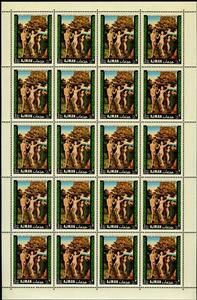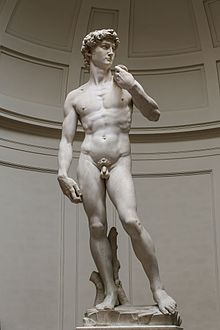Full Pane: The Fall, Hugo van der Goes (Ajman 1968)
The Fall, Hugo van der Goes (Ajman 1968)
05 July (Ajman ) within release Paintings: Adam and Eve goes into circulation Full Pane The Fall, Hugo van der Goes face value 20*2 United Arab Emirates riyal
| Full Pane The Fall, Hugo van der Goes in catalogues | |
|---|---|
| Colnect codes: | Col: AJ 1968.07.05-4b |
Full Pane is square format.
Full pane not mentioned by MichelAlso in the issue Paintings: Adam and Eve:
- Stamp - Adam by Albrecht Dürer (1471-1528), german painter face value 2;
- Stamp - The Fall (12th century) face value 2;
- Stamp - Adam and Eve by Lucas Cranach t.E. (1472-1553) german painte face value 2;
- Stamp - The Fall by Hugo van der Goes (about 1440-1482) face value 2;
- Stamp - Adam and Eve, by Lucas Cranach t.E. (1472-1553) face value 2;
- Stamp - Adam by Albrecht Dürer (1471-1528) face value 2;
- Souvenir Sheet - Adam, by Albrecht Dürer face value 5;
- Stamp - The Fall by Hugo van der Goes (about 1440-1482) face value 2;
- Stamp - The Fall by Maderuelo (12th century) face value 2;
- Full Pane - Adam and Eve, Lucas Cranach face value 20*2;
- Full Pane - Adam and Eve, Lucas Cranach face value 20*2;
- Full Pane - Adam, Albrecht Dürer face value 20*2;
- Full Pane - Adam, Albrecht Dürer face value 20*2;
- Full Pane - The Fall, Hugo van der Goes face value 20*2;
- Full Pane - The Fall, Hugo van der Goes face value 20*2;
- Full Pane - The Fall, Maderuelo face value 20*2;
- Full Pane - The Fall, Maderuelo face value 20*2;
Full Pane The Fall, Hugo van der Goes it reflects the thematic directions:
The nude, as a form of visual art that focuses on the unclothed human figure, is an enduring tradition in Western art. It was a preoccupation of Ancient Greek art, and after a semi-dormant period in the Middle Ages returned to a central position with the Renaissance. Unclothed figures often also play a part in other types of art, such as history painting, including allegorical and religious art, portraiture, or the decorative arts. From prehistory to the earliest civilizations, nude female figures were generally understood to be symbols of fertility or well-being.
Painting is a visual art, which is characterized by the practice of applying paint, pigment, color or other medium to a solid surface The medium is commonly applied to the base with a brush, but other implements, such as knives, sponges, and airbrushes, may be used. One who produces paintings is called a painter.
Painting is the practice of applying paint, pigment, color or other medium to a solid surface (support base). The medium is commonly applied to the base with a brush, but other implements, such as knives, sponges, and airbrushes, can be used. Painting is a mode of creative expression, and the forms are numerous. Drawing, gesture (as in gestural painting), composition, narration (as in narrative art), or abstraction (as in abstract art), among other aesthetic modes, may serve to manifest the expressive and conceptual intention of the practitioner. Paintings can be naturalistic and representational (as in a still life or landscape painting), photographic, abstract, narrative, symbolistic (as in Symbolist art), emotive (as in Expressionism), or political in nature (as in Artivism). A portion of the history of painting in both Eastern and Western art is dominated by spiritual motifs and ideas. Examples of this kind of painting range from artwork depicting mythological figures on pottery, to Biblical scenes rendered on the interior walls and ceiling of the Sistine Chapel, to scenes from the life of Buddha or other images of Eastern religious origin. In art, the term painting describes both the act and the result of the action. The support for paintings includes such surfaces as walls, paper, canvas, wood, glass, lacquer, clay, leaf, copper and concrete, and the painting may incorporate multiple other materials including sand, clay, paper, plaster, gold leaf, as well as objects. The term painting is also used outside of art as a common trade among craftsmen and builders.
Religion is any cultural system of designated behaviors and practices, world views, texts, sanctified places, ethics, or organizations, that relate humanity to the supernatural or transcendental. Religions relate humanity to what anthropologist Clifford Geertz has referred to as a cosmic "order of existence". Different religions may or may not contain various elements ranging from the "divine", "sacred things", "faith", a "supernatural being or supernatural beings" or "some sort of ultimacy and transcendence that will provide norms and power for the rest of life". Religious practices may include rituals, sermons, commemoration or veneration (of deities), sacrifices, festivals, feasts, trances, initiations, funerary services, matrimonial services, meditation, prayer, music, art, dance, public service, or other aspects of human culture. Religions have sacred histories and narratives, which may be preserved in sacred scriptures, and symbols and holy places, that aim mostly to give a meaning to life. Religions may contain symbolic stories, which are sometimes said by followers to be true, that have the side purpose of explaining the origin of life, the Universe and other things. Traditionally, faith, in addition to reason, has been considered a source of religious beliefs. There are an estimated 10,000 distinct religions worldwide. About 84% of the world's population is affiliated with one of the five largest religions, namely Christianity, Islam, Hinduism, Buddhism or forms of folk religion.




